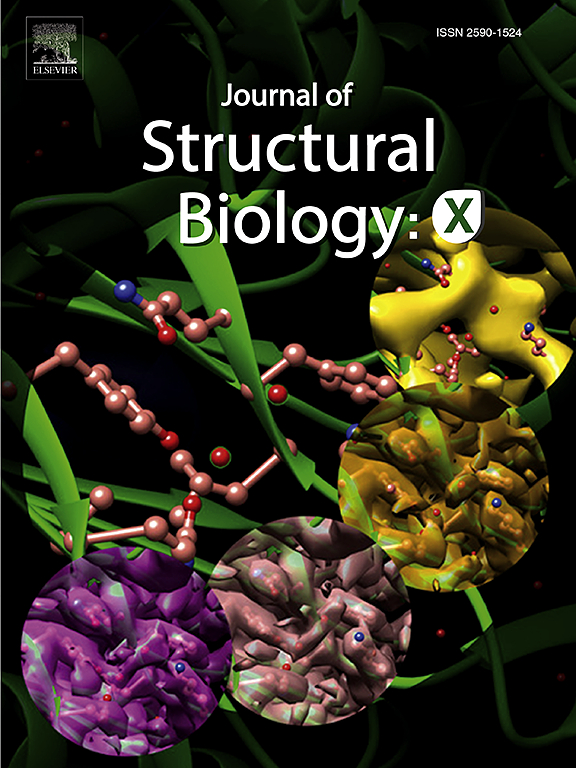优先结合作为脂质结构域形成的驱动机制。
IF 2.7
3区 生物学
Q3 BIOCHEMISTRY & MOLECULAR BIOLOGY
引用次数: 0
摘要
脂质膜是一种独特而复杂的生物结构,在许多生物过程中具有巨大的调控潜力,这是由于脂质膜在吸附各种客体分子(掺杂剂)时结构发生了多种变化。本研究致力于探索在单脂膜中自发形成的掺杂剂驱动的脂质结构域,通过实验观察到掺杂剂具有双峰吸附。利用我们提出的原始模拟方法和数值模型,工作提供了广泛不同情况下的结果。该方法的中心思想是“像环境一样”的掺杂结合,即优先结合。确定了优先结合程度的取值范围,形成稳定结构域,其大小分布趋于稳定。域尺寸分布密度呈幂律分布,即域模式具有自相似性。在此范围之外,如果范围太大,则只有一个相占主导地位,而如果范围太小,则观察到膜的分散很大,因此膜在物理上是均匀的。考虑了掺杂剂结合概率的各种邻域和不同计算方法。所得结果在数量上有差异,但在质量上无差异。建议的模型和领域定义与渗流理论中使用的模型和领域定义相似。因此,所得结果可应用于渗流问题。基于对各种脂质系统中形成的结构域模式的文献数据分析,我们认为优先结合机制符合这些系统中隐含的优先邻近机制,而不考虑其具体性质。本文章由计算机程序翻译,如有差异,请以英文原文为准。

Preferential binding as a driving mechanism of lipid domains formation
Lipid membranes are uniquely complex biological structures with large and still undisclosed regulatory potential in many living processes caused by versatile changes in their structure while adsorption of various guest molecules (dopants). This work is devoted to exploring spontaneous dopant-driven formation of lipid domains in a monolipid membrane observed experimentally for dopants with bimodal adsorption. The work offers the results obtained for a wide range of different cases exploiting our proposed original simulation method and numerical model. The central idea of the approach is dopant binding ‘like the surroundings’, i.e. preferential binding.
The value range of the preferential binding extent was determined, where stable domains are formed and their size distribution becomes steady. The density of domain size distribution is power-law, i.e. the domain patterns possesses self-similarity. Outside this range, only one phase dominates if the extent is too large, whereas if it is too small, great dispersion of membrane was observed, so the membrane is physically homogeneous. Various neighboring as well as different methods of calculation of dopant binding probabilities are considered. The results obtained differed quantitatively but not qualitatively. The suggested model and the domain definition are similar to those used in percolation theory. Thus, the results can be applicated to percolation problems.
Grounding on analysis of literature data on domain patterns formed in various lipid systems, we suggested that the preferential binding mechanism is in line with the mechanism of preferential neighboring which is implicitly assumed in such systems irrespective of their specific nature.
求助全文
通过发布文献求助,成功后即可免费获取论文全文。
去求助
来源期刊

Journal of structural biology
生物-生化与分子生物学
CiteScore
6.30
自引率
3.30%
发文量
88
审稿时长
65 days
期刊介绍:
Journal of Structural Biology (JSB) has an open access mirror journal, the Journal of Structural Biology: X (JSBX), sharing the same aims and scope, editorial team, submission system and rigorous peer review. Since both journals share the same editorial system, you may submit your manuscript via either journal homepage. You will be prompted during submission (and revision) to choose in which to publish your article. The editors and reviewers are not aware of the choice you made until the article has been published online. JSB and JSBX publish papers dealing with the structural analysis of living material at every level of organization by all methods that lead to an understanding of biological function in terms of molecular and supermolecular structure.
Techniques covered include:
• Light microscopy including confocal microscopy
• All types of electron microscopy
• X-ray diffraction
• Nuclear magnetic resonance
• Scanning force microscopy, scanning probe microscopy, and tunneling microscopy
• Digital image processing
• Computational insights into structure
 求助内容:
求助内容: 应助结果提醒方式:
应助结果提醒方式:


